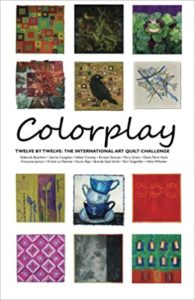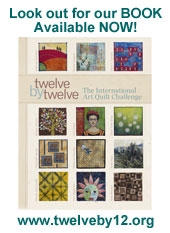Today is Day Eleven of our giveaway to celebrate the publication of our book
Twelve by Twelve: The International Art Quilt Challenge.
You know, by now, how this goes. Each day, for twelve days, we are asking you a different question. For a chance to win a copy of our book, just leave us a comment on any of the Book Release Celebration posts with your answer to the relevant question. Feel free to play every day! At the end of the twelve days, one lucky winner will be randomly selected. We will need to know how to contact you if you are the winner, so be sure to include an email address if you aren't linked to a blog or profile with that information. The book drawing is closed. Stay tuned for the winner details.
Terry Grant here. The chapter I wrote for the book was about the theme of
Passion, proposed by Kirsten. Yikes! That was such a hard theme to come together in my mind, and yet it turned out to be probably the most ambitious of all the pieces I made for the theme series. My chapter talks about why I chose Frida Kahlo as the subject representing Passion and the research I did to create her portrait, as well as the varied approaches the rest of the Twelves took to Passion.
One thing I determined early on was that for quilts of this size I seldom liked using a traditional binding to finish the quilt. It seemed too heavy for most of mine. Some I backed with a pillowcase backing, some I faced and some I finished using a technique I figured out that was essentially couching a piece of heavy perle cotton or cording of some kind around the edge (see
Terry's online tutorial). For my passion piece, I tied little knots in the cording at each corner. So here is today's question:
What is your favorite finishing technique for art quilts?





30 comments:
I mostly use a facing finish.
I don't know yet. I am a newbie and have not made an art quilt.
lag110 at mchsi dot com
I don't really have a favourite. I choose each edge finish to suit the style of the quilt. I use either a narrow or wide binding, a facing finish or for small quilts I have also used the couching finish. Sometimes twisting knitting wool or other threads and braids together before couching to the edge.
I like to embellish the bound edge sometimes - either stitching an extra line of stitching inside the quilt top close up to the binding, or adding beads as I sew the binding down - in this case the binding is put on back to front.
Lately, my twelve by twelves have been made to fit on a 12 x 12 frame with a wood back that my husband has created. I will probably wrap the fabric around the edges and either staple or glue it to the wood, much like a canvas for a painting.
That's a good question! Mostly I'm exploring anything but a binding! Sad thing is - most traditional judges like to take off points for "improper finishing" if you don't use a binding!
Mostly I do facing finishes- although I have used your perle cotton technique, Terry, and really like it.
I still want to be part of the book drawing however I don't have a favorite finishing technique since I do not quilt. If I did quilt my favorite finishing would be just to get it done. This Freida 12x12 is amazing.
It depends on the piece. I usually use a facing or traditional binding. I have used your pearl cotton technique and I have left some edges raw. Of course, I am not entering competitions, so it is only myself I have to please.:)
The quilt usually dictates the binding. But more often than not I find myself making a facing as demonstrated by Carol Taylor.
I love your technique of using heavy perle cotton on smaller quilts and anymore, for postcards I couch it directly to the edge...it is so easy and so neat and tidy!
I love to finish my landscape quilts with a chenille yarn couched edge. It is easy and fast and you do it all on the machine. It is a technique I learned on Nellie Durand's blog.
Facings are what I like, although I have several ways of doing them -- backing fabric turned forward and under top, when I want to preserve the raw edge...top fabric turned to back with 1" or smaller facing...more typical facing sewn to the edges and turned back. I also really like French binding, especially on small pieces.
I am still doing regular bindings though I am reading and studying up on the different ways to do so. I must agree that facing a binding makes a wonderful statement. I also agree that the binding technique should fit the quilt. How great to haveso many choices
Marsha in Va Beach
I use different finishes depending on the quilt - I enjoy binding larger pieces but on smaller quilts I often use a machine satin stitch
I'm not that much of an art quilter, but I've used yarn couched to an edge and so facing - binding is my go to finish though.
I have not done many art quilts yet and I mostly have used traditional techniques but am exploring new ones to try. I am sure different quilts call for different finishes.
Hi Terry:
I so enjoyed reading your chapter of the book! Each of you have such a different take on your themes. I particularly liked reading about your technique for portraits; very unusual, and very dramatic. It gives a lot of substance to the focus of your art piece.
On traditional quilts, I always use a bias binding, but on the art quilts I've made (five so far), I like using straight, on-grain bindings that are as narrow as I can make them -- usually less than a quarter of an inch. Although there is one 12 x 12 art quilt that I used a bias binding on because I wanted to see diagonal stripes at the edges of the piece.
Carolyn in SoCal
I think edge finish really depends on the piece. Sometimes facing, sometimes your edge finish, sometimes binding (especially when the top is not quite big enough to do anything else).
I’ve only made a few little ‘art’ quilts, and finished them with a small binding, but I’m curious to learn about other techniques.
My favourite is to self bind so that the front is mitred on the back, however it depends on the use the piece is to be put and on the size of the piece. For a small piece, I do like satin stitch edgings, esp for post cards and ATCs
It totally depends on the flavor of the piece. I am a fan of machine stitching so I do like to do a satin stitch edge on lots of them. I also like facings, and sometimes the pinking blade finish.
Lately, it is mostly facing. But I do want to try your technique sometime.
Favourite finishing technique you ask? Hmmm... needle and thread ;) Just kidding! I have yet to make what I consider an art quilt. I have a rather large one in the works, but that will be done with a regular binding. I suppose the binding/finishing I would use would depend on the effect that I was trying to express with the art piece.
I'll either couch something around the edge or do a single fold binding
Whatever seems appropriate: facings for larger quilts; facings or zig-zag + cord/perle thread for smaller
I;m still a binding kind of gal but open for new ideas.
I'm just getting started...your book is giving me lots of ideas.
I don't have one favourite. It all depends on what the quilt requires, although if I am doing very small art quilts, I rather like satin stitched edges, or braid attached.
I like couched edges, turning the backing over to the front to form a binding, or a bagged finish.
I prefer to use a knife edge - front and back folded inwards. But you have to remember about this when you are quilting, and stop well before the edge - so when I remember I trim and turn the edge before I do the majority of the quilting. No bulges if I pin it very firmly - or fuse fron tand back.
Post a Comment